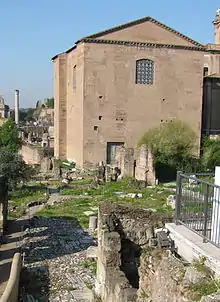Argiletum
The Argiletum (Latin Argīlētum, Italian: Argileto) was the main route approaching the Forum Romanum from the northeast in the ancient city of Rome.[1] It connected the Forum with the Subura district of the city. Paths that were found in the Alta Semita and the domus on the Oppian and Caelian hills converged onto the Argiletum, making it a principal node of public space particularly during the Flavian rule.[2]

Development
Varro claimed that the etymology of the term argiletum was connected with the name of a Greek scoundrel.[3] As it originally passed between Comitium and Basilica Pauli, the Argiletum was eventually absorbed by the construction of the imperial fora from the time of Julius Caesar onwards. Given this encroachment, the limits of the Argiletum were defined differently in various periods. One of the landmarks excavated in the area was a quadrifrons, which was located at the juncture of the Forum Romanum, Argiletum, and Forum of Caesar.[4] It is suggested that a second arch or a temple was also constructed somewhere on the Argiletum, possibly close to the templum iani in the Forum.[4]
By the time of Martial (died ca 103 CE) the Argiletum had become a seedy district filled with taverns and brothels.[5] However, an account cited that this reputation did not reflect the actual status of the residents since the population was constituted by a mix of elite and nonelite, side by side.[6]
Livy indicates that the temple of Ianus Geminus was located ad infimum Argiletum (Liv. 1.19.1).[7]
References
- L. Richardson, jr (1 October 1992). A New Topographical Dictionary of Ancient Rome. JHU Press. pp. 39–. ISBN 978-0-8018-4300-6.
- Martin-McAuliffe, Samantha L.; Millette, Daniel M. (2017-12-06). Ancient Urban Planning in the Mediterranean: New Research Directions. Routledge. ISBN 9781317181323.
- Varro, De Lingua Latina 5.157.8 http://latin.packhum.org/loc/684/1/17/7101-7110
- Bradley, Mark (2012). Rome, Pollution and Propriety: Dirt, Disease and Hygiene in the Eternal City from Antiquity to Modernity. Cambridge: Cambridge University Press. pp. 94–95. ISBN 9781107014435.
- Martial 1.2.7-8; 1.3.1; 1.117.9-12; 2.17
- Mignone, Lisa Marie (2016). The Republican Aventine and Rome's Social Order. Ann Arbor, Michigan: University of Michigan Press. p. 110. ISBN 9780472119882.
- Ovid; Thomas Keightley (1848). Ovid's Fasti; with introduction, notes, and excursus. By T. Keightley. Second edition ... considerably improved. Whittaker and Company. pp. 226–.